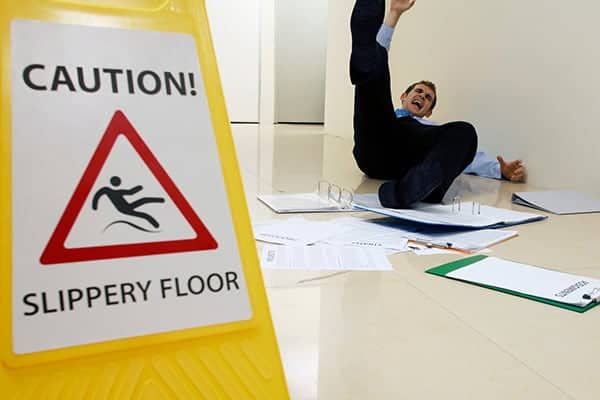
What is the most common cause of accidents at work?
Posted on 27th September 2021 by Phil Ainley
It’s imperative that staff feel safe in the workplace but accidents do happen and sometimes, no matter what preventative measures are in place, they’re out of your control as a business owner. But this doesn’t mean you should ignore the risks altogether and it might be good to discover some of the most common accidents in the workplace so that a risk assessment or risk management audit(1) can be completed.
A workplace should be a safe area for staff members and employees, to ensure that this is the case, accidents should be reported as soon as possible. You should also have an employers’ liability insurance policy in place so that medical costs, legal costs and loss of income are covered should an employee become injured.
Below, you can find the most common accidents at work and how you can prevent them, as well as more detail around manual-handling incidents and accidents involving large vehicles.
What causes accidents at work?
There are tons of ways an accident can happen and you can’t account for all of them. But, you can try to prevent the most common ones. These include:
• Slips, trips and falls
Of all accidents in the workplace, slips, trips and falls account for a total 29%. This figure increases to 37% when you include falls from a height(2).
Trips are generally caused by obstructions, it’s really important to ensure walkways are clear and that the floor is suitable. An old floor that is threadbare or loose can be a potential trip hazard and even poor lighting can conceal uneven flooring or steps. Footwear should be checked to ensure it has a good grip on the flooring that’s installed throughout the building or workplace and spills should be cleaned up immediately to prevent slipping.
The Health and Safety Executive has a hazard checklist that you can use to help prevent trips or falls in your workplace. A risk assessment could help you to identify potential incidents too and put measures in place to prevent them. For instance, a wet floor sign should be put down when there’s a spillage or water on the floor and stairs should be made more obvious with fluorescent tape or improved lighting. When an accident does occur, it should be reported so that further measures can be put in place to reduce the risk of it happening again.
• Handling, lifting and carrying
There are many workplaces that require employees to lift or handle heavy items, including construction, warehousing, retail and more. However, incorrect handling can lead to accidents and injuries.
What percentage of work-based injuries are manual-handling related?
Handling, lifting and carrying account for just less than 20% of accidents at work. For this reason, it’s imperative that your employees are properly trained in how to lift heavy items, and that you ensure they’re not lifting more than they can manage by limiting the weight of certain items.
For items over a certain weight, it may be a good idea to have a policy in place that says they must get assistance from another person or use a lifting aid, like a forklift truck or a hoist.
In the food and drink industry, manual handling incidents increase to around 30%. Approximately 60% of these manual handling incidents are from lifting heavy items and the rest are caused by packing products, pushing wheeled racks and stacking or unstacking crates.
• Being struck by a moving object
Being hit with a moving object is the third most common type of accident in the workplace and is the reason for 11% of workplace injuries(3). Broken down, around a third of these total incidents are caused by falling items and a quarter by hand tools, like knives. A fair percentage are also caused by moving vehicles.
What percentage of work-zone related incidents involve large trucks?
It’s hard to give a precise figure for how many accidents in the workplace involve large lorries or trucks. This is because there are multiple types of incidents that could happen regarding these vehicles but we’ve gathered some figures below to give you an idea.
Around 3% of injuries in the workplace involve falling from a vehicle and in fatal accidents. Around 25% were caused by being struck by a moving vehicle. The latter is the most common cause of fatal work accidents.
• Acts of violence
Violence between employees or members of the public often gets overlooked as an accident or injury but this is the cause of around 9% of incidents at work. According to the HSE, there were 739,000 violence-at-work incidents in 2019, broken down into 356,000 actual assaults and 383,000 threats(4). In the majority of such incidents, around 6 in 10 offenders were complete strangers to the assaulted. This means that it’s less likely that violence will break out among staff and more likely to come from a member of the public or non-clients. Injuries vary from a black eye or minor bruising (80%) to scratches (25%) and severe bruising (18%).
For people that work as police officers, security guards or health professionals, the risk of being injured by violence is higher.
When these incidents, that we’ve reported above can be prevented, it means your staff feel safer at work and they spend less time off sick. In 2019-20, around 38.8 million working days were lost due to work-related ill health (including mental illness) and non-fatal injuries(1). While not all cases can be resolved by putting preventative measures in place, a large amount could, which might make a big difference to your workforce and their productivity.
For quotations for your personal accident insurance please call us on 0333 321 1403. Or click on the quote button below.
Start your quick online insurance quote here
Sources:
- (1) https://www.caunceohara.co.uk/knowledge-centre/an-introduction-to-risk-management/
- (2) https://vatix.com/blog/what-are-the-most-common-causes-accidents-at-work/
- (3) https://www.hse.gov.uk/statistics/causinj/index.htm
- (4) https://www.hse.gov.uk/statistics/causinj/violence/work-related-violence-report-19.pdf
Related Articles:
Managing and reporting an accident when you’re self-employed
Why Personal Accident and Sickness Insurance is important to Freelancers
A 6 Step Guide to making a claim against your Personal Accident and Sickness Insurance
Useful Links

Professional Indemnity Insurance
Protects against claims of alleged negligence in your professional services, advice and designs.

Employers' Liability Insurance
A legal requirement for anyone employing staff. Protects your business in-case an employee is injured at work.

Management Consultants

